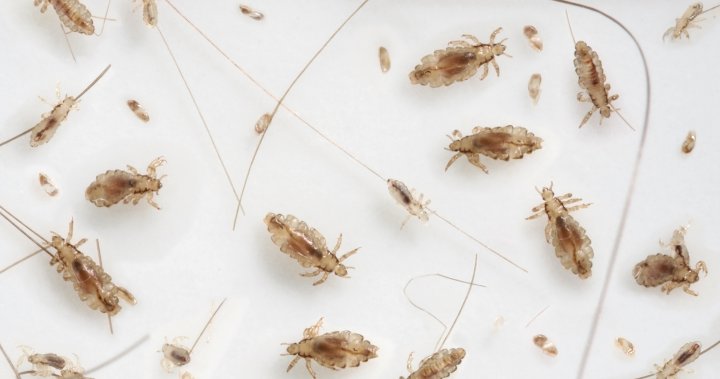Creepy crawly head lice are troublesome enough, but a highly resistant strain spreading across Canada is adding to the headache.
These so-called super lice, fortified with increased resistance to traditional treatments, are proving a challenge for those seeking to rid themselves of the persistent pests, health experts warn.
The genetic mutations in super lice have rendered them resistant to numerous over-the-counter and prescription medicated shampoos containing chemicals like pyrethrins and permethrin. This resistance, which has been growing for decades, has spurred new methods of controlling lice.
“Head lice are becoming resistant to the commonly used chemicals that have been around forever that have been used to eradicate them,” said Sherry Torkos, an Ontario-based pharmacist and health author. “Just like how bacteria have become resistant to some antibiotics, the same thing is happening with head lice: they have developed a genetic mutation.”
Head lice are parasitic six-legged insects that live on the human scalp, feed on blood and lay eggs. They are not associated with disease spread or poor hygiene but are more of a nuisance and can be difficult to treat, according to the Canadian Paediatric Society (CPS).

Infestations are common among school-aged children and can spread easily through close contact, sharing personal items like combs or hats, or contact with infested furniture or bedding.
Infested children usually carry less than 20 mature head lice at a time, which live three to four weeks if left untreated, CPS stated on its website. They live close to the scalp surface as it provides food, warmth, shelter and moisture, which is what causes the itching and irritation.
“They also don’t care whether your scalp or your hair is oily or freshly washed,” Torkos said.
“It’s also important to know that when you have head lice, regular shampoos will not get rid of them. And that’s because the mother lays the eggs with and releases a cement or glue-like substance that attaches the egg firmly to the shaft of the hair. So in order to get rid of the lice, you need to use a lice treatment product.“
How head lice became stronger
The special over-the-counter shampoos for head lice contain plant-derived insecticides known as pyrethrins or their synthetic counterparts, called pyrethroids.
The latest health and medical news
emailed to you every Sunday.
“Some of the first treatments for head lice came out in the late ’70s and early ’80s, and when they first came out, they were highly effective,” Torkos said. “But their efficacy has dwindled significantly over the last few decades because the head lice are getting smarter, stronger, and they are becoming resistant to the pesticides.”
According to the Canadian Paediatric Society, treatments with pyrethrin and permethrin, over time, head lice have become resistant to some of the chemicals used to kill them, so some products may be less effective than they used to be. “But they are still worth trying,” CPS said on its website.
A 2014 study by the Journal of Medical Entomology suggests 97 per cent of North American lice sampled have evolved into a powerful strain of bugs immune to the key ingredient used in most treatment products such as creams, sprays and shampoos.

In another study from 2021, published in BMJ Paediatrics, it was argued that the primary therapy, which has relied on insecticidal-based approaches to treat head lice, may not be as effective anymore. The researchers said the “accumulating evidence” of resistance to insecticidal treatments like pyrethrins and permethrin has created a pressing need to develop newer and more efficient treatments for head lice.
Torkos, as a pharmacist, noted that she and her colleagues have repeatedly witnessed parents coming in, expressing frustration that the traditional method of chemical shampoos isn’t effective. This cycle of trying and retrying not only costs time and money but also imposes hardships on the family, she said.
“When you’re dealing with head lice as a parent, I know you want to get rid of it right away,” she said. “You don’t want to have to buy multiple products, keep going back to the pharmacy because that means missed school days for the children, missed workdays for the parents, more time, more stress. So I think it’s important to keep that in mind when you’re looking at products there are big differences with respect to how they work and their efficacy.”
What are some alternative treatments?
There are other methods of getting rid of lice that are not chemical methods and are approved by Health Canada, Torkos said.
One of them is called isopropyl myristate, which is a non-chemical treatment option for head lice. It is an oily substance that works by dissolving the wax layer that covers the exoskeleton of lice, leading to dehydration and death.
Health Canada has approved the use of a new non-insecticidal product containing isopropyl myristate for the treatment of head lice in children four years of age, the Canadian Paediatric Society states on its website.
“Its efficacy ranges from 52 to 84 per cent in killing lice,” Torkos said. “It doesn’t have a whole lot of efficacy in killing eggs so that particular product requires three applications.”
Torkos typically recommends a more potent product to parents — one containing dimethicone. Dimethicone, a type of silicone oil, effectively suffocates and immobilizes lice and their eggs.
“The dimethicone has been shown in clinical studies to be 100 per cent ovicidal (killing the eggs),” she said. “So if the product is applied properly, it has to be sprayed onto the scalp. Massage through and after 30 minutes, you comb it out and then you put a shower cap and then you leave it on for eight hours so it could be left on overnight or during the day with that shower cap on.”

She added this product is also typically well tolerated and “doesn’t cause the itching, the burning, the stinging and the reactions that we see with the pesticides treatments.”
The Canadian Paediatric Society recommends using it for children over the age of two.
Benzyl alcohol lotion is also approved for use in Canada, the Canadian Paediatric Society said. This product is “highly effective against live lice” but not at killing the eggs. Therefore, a second treatment is required. This product is approved for use in individuals six months to 60 years old and skin irritation is the only common side effect.
Several household products, including mayonnaise, petroleum jelly, olive oil, tub margarine and thick hair gel, have been proposed as treatments for head lice. However, according to the Canadian Paediatric Society, these remedies are not as effective at killing lice as topical insecticides. There are no published trials regarding the safety or efficacy of these home remedies.
When it comes to cost, Torkos suggested consulting with a pharmacist, especially since certain provinces like Ontario provide insurance coverage for both chemical and non-chemical head lice treatments.

She added that head lice are typically seen as a problem when kids start school in September, but warned that it happens during the summer months too when kids are at day camps as lice are transmitted primarily by head-to-head contact.
“It’s kids that are getting their heads together and playing or doing each other’s hair. (Lice) can’t fly and they can’t jump, but they do crawl and they move fast,” Torkos said.
“We always advise families to tell their children not to share hats and combs and hairpieces because transmission is possible.”




